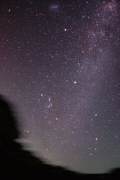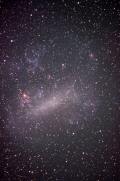| The Milky Way from Centaurus to Carina. The Pointers, "Coal Sack" dark nebula in Crux, the h Carinae Nebula together with numerous open star clusters are prominent; 5 min exposure through a 55mm lens at f/1.7 onto Fuji P-400F slide film. | |
| The magnificent region around r Ophiuchi. Emission, reflection and dark nebulae abound in this Milky Way field. Antares is middle right flanked by s and t Scorpii with the globular cluster M4 above; 30min unguided exposure through a 180mm lens at f/2.5. | |
| The Helix Nebula (NGC7293) in Aquarius. The closest known planetary nebula to our solar system, it is spacially rather large and of low surface brightness; 20min unguided exposure through a 400mm lens combination operating at f/4. | |
| The glorious Milky Way stretching from Sagittarius, lower left, to Carina, upper right, imaged April 2005. Scorpius is mid frame; 37 minute exposure onto P-400F through a 16mm lens at f/2.8. The LMC is visible on right of frame. | |
| Sagittarius and the wonderful Milky Way star fields rising April 2005. A wealth of detail is visible; 10min exposure through a 28mm lens operating at f/1.8. | |
| A close-up of the spectacular dark nebulae in Sagittarius; 10min exposure through a 180mm lens at f/2.5. | |
| The Milky Way from Carina to Gemini. At the top right are the rich star fields containing the eta Carina nebula and the Gum Nebula, whilst lower left is Orion. Sirius is the bright star middle frame, middle top is the Large Magellanic Cloud, whilst Saturn is the brightest "star" lower right; 30 min exposure onto Fuji P-400F through a 16mm lens at f/2.8. | |
| Crux, The Southern Cross, up close. Note the dark nebula known as "The Coal Sack" that hides stars behind; 5min exposure onto Fuji P-400F through a 135mm lens at f/2.8. | |
| The Small Magellanic Cloud up close from 240,000 light years; 10 min exposure through a 180mm lens at f/2.5 onto Fuji Provia 400F film (frame cropped by about 70%). Stars and emission nebulae in the galaxy are resolved, as are stars in 47 Tucanae (NGC104) and NGC362 (globular clusters in our own galaxy). | |
| The Large Magellanic Cloud up close from 165,000 light years; 10 min exposure through a 180mm lens at f/2.5 onto Fuji P-400F film (frame cropped by about 40%). Numerous stars and emission nebulae are resolved; the bright red object is the well known Tarantula Nebula. The brightest supernova since 1604 (SN1987A) exploded near there in 1987. | |
| The glorious star-studded region surrounding h Carinae (mid frame); 10 min exposure through a 180mm lens at f/2.5 onto Fuji Provia 400F film. Numerous star clusters and emission nebulae are visible. The "Southern Pleiades" or the q Carinae cluster is to the right of the frame. | |
| Star trails around the South Celestial Pole; 30 minute fixed camera exposure through a 16mm lens at f/2.8. The Pointers and Crux are at the bottom of the frame, the Milky Way and the two Magellanic Clouds are clearly shown. Scorpius/Sagittarius are to the right whilst Canopus is the bright trail left frame. | |
| Star trails around the South Celestial Pole. My first astrophoto a 40min exposure taken from Melbourne in 1966 when I was just 12 yrs old! b Carinae is the bright star at top right. |
vsm.jpg)










